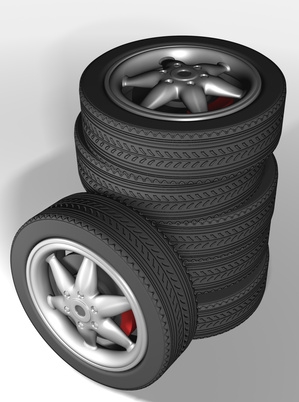
Tire pressure fluctuates with the seasons; sometimes, tires will go almost flat in the coldest temperatures. That happens because air, like any other gas, behaves according to the ideal gas law, a rule of physical chemistry that states pressure, volume, weight and temperature are interrelated. In other words: As the temperature drops, so does the tire pressure.
The Ideal Gas law, sometimes also called the Van der Walls equation, is written pV = nRT, in which "p" equals absolute pressure, "V" equals volume, "n" equals amount, "R" equals the gas constant, and "T" equals temperature.
Algebra can show that colder air equals flatter tires. In the pV = nRT equation, an increased temperature, "T," results in an increased pressure, "p," and volume, "V." In other words, when "T" increases, so do "p" and "V." When "T" decreases, so do "p" and "V."
How much temperature affects pressure and volume depends largely on the gas inside a tire.

Correct tire pressure is paramount to vehicle safety. Under-inflation decreases traction, which can give a mushy feeling in the steering, increase braking distance, and cause damage your tires.
Under-inflated tires put most of the car's weight on the edge of the tires, just under the sidewalls, which squishes the tire as you drive. The added pressure on the sidewalls heats up the tire and can result in damage. A very low tire can lead to a blowout from heat and sidewall flexing.
Unless your car is overloaded, a manufacturer's recommended tire pressure is the optimum pressure.
Under all applications and driving conditions, an under-inflated tire will reduce performance and traction. There is no advantage to letting air out of tires under icy or wet conditions, and "bleeding" (lowering pressure during long trips) is dangerous and not recommended.
Tires are designed to perform best when inflated to the recommended pressure from the beginning of a trip. Under-inflated tires will increase the distance it takes your car to stop and decrease handling.
Compressed air isn't the only thing used to fill car tires. Compressed nitrogen gas is a suitable, albeit more expensive, alternative because ambient air temperature has less of an effect on nitrogen.

Check tire pressure at least once a month, and always before long trips. When checking the pressure, it is important to be sure the air inside the tire is the same temperature as the air around you. Checking and inflating tires after driving just one mile can give a high reading, and you'll end up with too much air in the tire after it has had a chance to cool.
Car manufacturers recommend tire pressure for normal use, which will provide optimum safety and performance. The number listed on the side of a tire is the wrong number to use---it is the maximum pressure the tire can hold. Car manufacturers' recommended tire pressures should be listed on a label on the end of the driver's door, or door frame, and in the owner's manual.
When all else fails, call a tire professional.

According to tire manufacturer Bridgestone, more people wash their cars in a month than check tire pressure. About 17 percent of drivers (fewer than one in five) check pressure once a month.
It's an easy check that requires only a pressure gauge and about two minutes of your time. Remember to do the check when your tires are cold.
First, find the stem on a tire and unscrew the cap. The stem sits somewhere along the seam between the tire and the wheel. Press the pressure gauge against the stem and apply pressure until you no longer hear air hissing as it escapes. If the gauge is seated properly, you will hear a brief hiss then get a reading. Your pressure reading will be inaccurate if you hear air leaking while you read the gauge.
When adjusting tire pressure, add or remove air slowly, stopping periodically to recheck pressure, until you reach the manufacturer's recommended pressure.
